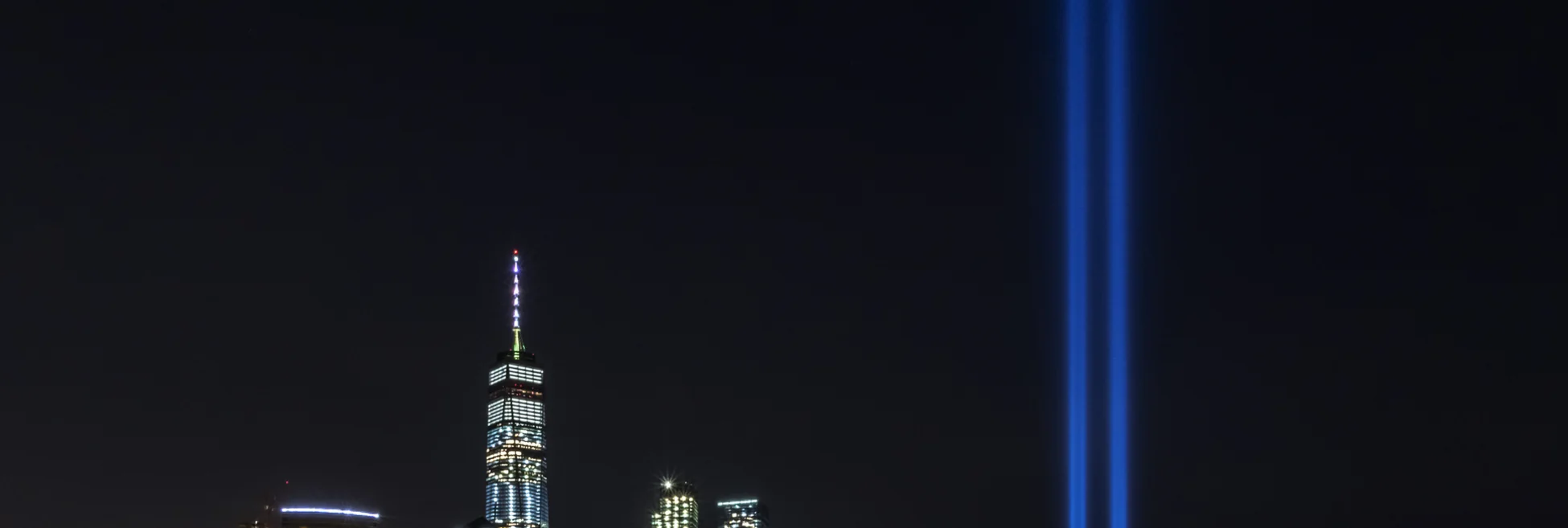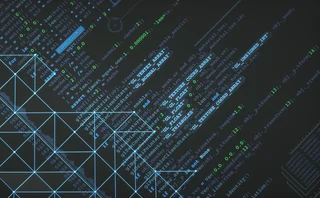
Remembering Our Friends and Colleagues
Today marks the 19th anniversary of the September 11 terrorist attacks. We remember those who died that day and later, as a result of injuries and illness sustained during the rescue and clean-up efforts.
It’s been almost two decades since the terrorist attacks of September 11, 2001. Each year, on this day, I prefer to let Peter Field speak for our entire staff. You can read the moving words he wrote after those terrible events below, but before that, there are two things I’d like to say on behalf of those who still work at what used to be known as Risk Waters Group.
As you’ll read, many Waters staff, and dozens more from the industry lost their lives that day, on what was to be our first-ever event in the North Tower of the World Trade Center. Just two days ago, we launched the inaugural WatersTechnology Innovation Exchange, a three-week event that’s being held virtually due to the effects of the coronavirus. When remembering 9/11, I find solace in the fact that we’re still coming together as a company to create new things. Yes, this is a business, and that’s why we’re doing it, but here we are, still creating.
On a more personal note, I joined Waters in 2010, and this company has allowed me to forge a career as a journalist. I was afforded that opportunity only because of the men and women who carried on the magazine after those attacks, who kept on building something, here, in the worst possible conditions, and in the face of such unimaginable loss. Over the last 10 years, I’ve met people with whom I’ll remain friends for as long as I live, thanks to this magazine. And it’s on this day that I’m most reminded of that fact—that privilege.
Finally, it’s a sad fact that, as an organization, we’ve lost track of many of the family and friends of those we lost that day. In the next year, I’d like to try to remedy that. If you are kin to one of those who were inside the Windows on the World on that day, we’d appreciate hearing your memories of those individuals. You can reach me at anthony.malakian@infopro-digital.com.
Sincerely,
Anthony Malakian
The Day I’ll Never Forget
Peter Field, then chairman and chief executive of Risk Waters Group, was scheduled to be at the Waters Congress in the World Trade Center on September 11, 2001. Here is what he wrote, chronicling the events of that day, and remembering the Risk Waters staff and conference participants who were so senselessly killed:
I was up at about 6:30 am to check my e-mail and phone the London office, intending to leave for the inaugural Waters Financial Technology Congress at the World Trade Center no later than 8 am. But I had trouble retrieving my e-mail and I decided to call our IT manager in London to get the problem sorted out. It was this simple act that probably saved my life. By the time I’d accessed my e-mail, I was running late, eventually leaving my hotel on the Upper West Side at about 8:10 am.
I ran across the road from my hotel to the 66th St. subway entrance only to find there was a long delay in the service on the 1 and 9 lines to the Cortlandt St./World Trade Center station. Eventually, I crammed myself onto a train at around 8:25 am. I thought: “I might still catch David’s opening remarks because the conference is bound to start a little late.” Delegates always register at the last minute on the first day of conferences. David Rivers, our company’s Editorial Director in New York, knew more about financial technology than many in the industry and was therefore ideal to open the first Waters Congress at Windows on the World, on the 106th floor of the north tower of the World Trade Center.
The subway train had thinned out by Chambers St., the stop before the Cortlandt St./World Trade Center stop. There was a short delay, then one of those loudspeaker announcements where only two words out of five are audible. The key words I caught were “explosion” and “World Trade Center.” The upshot was the train wasn’t going any further and we were told to get off. Then we were told to get back on, then off again. Finally, the voice clearly said the train would now be going on to Cortlandt St. So I assumed that the explosion had been a minor one. Otherwise, why would the train be allowed to go on?
How wrong I was. As soon as I went through the exit barriers at Cortlandt St., there was a sickening smell of what I thought was gas but which I later discovered was jet fuel. It was now between 8:50 am and 8:55 am, a few minutes after the first plane had struck at 8:46 am. On the shopping concourse above the station, I remember a brief glimpse of broken glass and a cacophony of alarms before I became aware of security guards screaming at us, “Run, run for your life.” Another official took the opposite tack: “OK folks, take your time.” But I didn’t hang around. Out onto the wide pavement and across the street.
I turned, looked up and saw an ugly gash in the side of the north tower with flames and smoke billowing out. Many of the hundreds of onlookers lining the street were on cell phones and I overheard one say something about a plane having crashed into the building. I thought: how could a plane do that in broad daylight? Is this the tower in which Windows on the World is located, and if so are our people high enough above that hole to have escaped the impact?
I walked down toward the corner of the street opposite the south tower, thinking I’d ask a policeman who was in animated conversation with someone on the corner. I paused to wait for the right moment to interrupt but I never got the chance. A few seconds later—it was 9:02 am—there was a roar in the sky rather than an explosion … and shouts and screams from the hundreds of people gathered around. I looked up to see a ball of fire erupting from the face of the south tower.
From where I was standing I had not been able to see the plane coming in. But I realized to my horror that what looked like an innocuous spray of particles fanning out in slow motion from the flames and smoke of this new explosion was in fact potentially lethal debris that would come raining down on us any second. Everyone seemed to realize this at the same instant and we all ran up the street away from the World Trade Center. I ran faster than most. A well-dressed woman went sprawling, dropping her cell phone, which went scooting along the ground. I recall jumping over somebody. I’m afraid I didn’t stop for anyone. I’ve never known group panic before but I kept thinking: this isn’t real, this isn’t actually happening, we’re on the set of a movie.
I was convinced that I’d be flattened by a lump of metal or concrete if I didn’t get under something. Stupidly, I paused under the awning of a newsstand, quickly telling myself that a plastic corrugated sheet was no match for flying building materials. I ran on to get round the corner and as I did something hit me on the leg. It was painful but not enough to stop me running. I rounded the corner and pressed my back to the wall.
I checked my leg—a nasty cut on my right calf—and then decided to get as far as possible away from the World Trade Center. I was also very concerned to get to a phone because I was worried that my wife Sonia in London would hear about the attack before I could tell her I was OK. I also wanted to call the office.
I didn’t know where I was but I knew which direction was away from the World Trade Center. Amazingly, people were still walking back toward the Twin Towers. Perhaps they wanted to help those who’d been hurt but I later wondered how many might have been overwhelmed by the collapse of the south tower. After about 10 minutes of walking, passing pay phones with long lines, I found some kind of community building with a phone inside. It still took what seemed an interminable time to take my turn in line. My wife’s cell phone wouldn’t connect, but I got through to our baby-minder at home and told her to get hold of my wife urgently to tell her I was OK. I later found out that Sonia was at Epsom Hospital outside London visiting my elderly aunt who had suffered a bad fall. The TV in the hospital was already broadcasting live the terrible events in New York. As soon as she could, Sonia phoned my office to ask if I was meant to be in the World Trade Center. She had to be told, of course, that I was. Luckily, the baby-minder managed to contact Sonia a few minutes later to say I was OK.
They were not the happiest minutes of her life. But at least she and I have the luxury of being able to recall these awful moments, unlike the thousands of victims who were torn from their loved ones that day.
I came out of the building and stood on the steps along with scores of other people. There was a clear view of the two towers on fire. Then I saw a chilling sight, something I didn’t believe at first: someone falling or jumping from near the top of the north tower. It seemed to take ages for them to disappear out of sight below the smaller buildings around the World Trade Center. I turned to a tall and rather unfriendly looking (but probably just horrified) youth next to me, who told me that this was the seventh or eighth person he’d seen jump.
I couldn’t watch any more, though plenty of people stood around me apparently glued to the spot, crying out at each new fall or sobbing quietly. I started to walk back to the Risk Waters office in SoHo. At every intersection large groups of people stood looking down the Lower West Side toward the unfolding tragedy. I walked up the West Side Highway, then started to cut across, until I got to West Broadway. In a coffee shop, I found a whole line of people watching live TV.
Now the remark I overheard earlier about a plane crashing into the World Trade Center was confirmed. Both towers, CNN said, had been victims of an “apparent” terrorist attack. At some point soon after, groans and shouts of “Oh no!” and “Oh my God!” erupted from onlookers as the first tower collapsed. I can’t honestly recall whether I saw it happen or not, or whether I just thought I’d seen it because I later saw it on TV so many times. I carried on and got to the office in SoHo around 10 am. When I walked in, everyone looked at me as if they’d seen a ghost.
We knew that our people had survived the impact of the plane, because someone in our office had called David Rivers on his cell phone right after the plane had crashed into the building and he sounded quite calm, saying they were all OK and waiting to be evacuated. Later either David or someone else who managed to phone from the 106th floor said it was getting smoky and they were being moved up to the 107th floor. For the next half an hour we kept telling ourselves: “They must have been evacuated by now.”
I missed the collapse of the second tower too. But there were screams in the office from where, on the corner of Prince and Lafayette, we had been able to see quite clearly the top halves of the World Trade Center. Nobody said anything for a while. Then we renewed our efforts of reassurance: our colleagues must have got out, we told each other, because they had had an hour and 45 minutes to do so.
Only then did we start to focus seriously on who exactly among our staff was meant to be there. David Rivers was the key editorial person in New York, and a man widely respected by everyone involved in financial IT. Married 17 years, he had a five-year-old son and a wife, Ricky, who was big in the world of fashion. They lived in the Village on Fifth Avenue. Only a couple of months earlier, David had decided against a family vacation in Israel where Ricky’s parents live on the grounds that there was too much risk from terrorist attacks. What an irony!
There was Simon Turner, a board director out from London on his last trip before his wife gave birth to their first child, due in November. He had to be there because the whole of the Waters business was his responsibility. His poor wife and his friends at first clung to the notion that he might have been late for the start of the conference, like me and some others, but they knew they were kidding themselves. Simon until a couple of years ago had been a keen member of the Honourable Artillery Company (the Territorial Army reservists). For him to be late for anything would have been like Big Ben failing to strike.
The night before, I had been at dinner with two other colleagues from London, Michele du Berry and Sarah Prothero, and we wanted Simon to join us, but his flight from London had been delayed and our calls to his hotel proved fruitless. The three of us had a pleasant meal in TriBeCa and got a cab back uptown, not too late since Michele and Sarah had to be up early to get to the conference the next day, well in advance of any delegates. They were in a happy mood as I dropped them off at their hotel in midtown. It was the last time I saw them.
Michele, Risk Waters’ conference director, had joined us less than a year ago and had brought stability to a managerially shaky department. She was married with two young children who adored her. After Sept. 11, the children wouldn’t let their father leave the house for work “in case he doesn’t come back, like mummy.” Sarah ran all the conference administration with telling efficiency, managing never to appear flustered. Three other colleagues flew over from London to be at the conference: Karlie Rogers, whom we’d just promoted to sponsorship manager in London; Elisa Ferraina, an Australian based in London and another stalwart of the sponsorship team; and Melanie de Vere, who perhaps would be alive today if she hadn’t been promoted from the Waters training division into a new publishing role, where her first task was to attend the conference in the World Trade Center.
There were other Britons living in New York. Dinah Webster and Neil Cudmore we had transferred together 18 months ago from Hong Kong where they had met and fallen in love. Dinah had been working for us in Hong Kong; Neil worked for us for a time there before defecting to another company. But he was eager to rejoin us in New York and Dinah was equally keen to be with him. They worked well together. They at first rented an apartment in Murray Hill but just a few months prior to the tragedy opted for more space in the suburbs, buying a place out on Long Island. They had got engaged in June 2000. When they were going to tie the knot wasn’t clear but anyone who saw them together couldn’t fail to notice how much they cared for each other.
Also at the conference that day were Oliver Bennett, a journalist with Risk, who was due to return to London at the end of October, and Paul Bristow, a conference producer whose first major event was the conference being held that day.
The local staff in New York included Amy Lamonsoff, one of the most loyal members of the staff we inherited when we acquired the New York company, Waters Information Services, in 1999. Her work in conference administration had won her a lot of friends and admirers in the London office.
Celeste Victoria, Joanna Vidal and Sarah Ali Escarcega were all in conference marketing and support functions. Celeste, a single mother, was helping her daughter through college somewhere in the Midwest. Sarah was on a temporary contract and had been with us a mere three weeks. She had married only in April. A sad discovery a week or so after Sept. 11 was that her father, who lives in north London, had suffered racial abuse for being a Muslim. Equally moving was the later revelation in The New York Times that Joanna, some time after the first plane rammed the north tower, had called her father on her cell phone from the 106th floor to tell him that the building was on fire and that, no matter what happened, she loved him.
There was also Laura Rockefeller, an aspiring theater producer, who funded her drama activities with part-time work, including ‘hosting’ activities at nearly all our New York conferences. She’d worked at the Windows on the World many times for Risk Waters.
All day the phones rang in our SoHo office. There were calls about members of staff, about speakers, exhibitors and delegates at the conference. We were soon able to calculate the number of Risk Waters staff attending at 16 but it took considerably longer to establish that, of the roughly 150 others expected to attend that morning, 65 had arrived at the conference. The callers—partners, parents, siblings, friends—ranged from calm to distraught. We told them what we could, which wasn’t very much. That was the awful part: not knowing. We grabbed at straws. A couple of times we got garbled third-hand messages that everyone had been safely evacuated and we became elated, only to find out later that the authors of the messages hadn’t actually been at the conference. Web sites proliferated, claiming to list those who were safe and those about whom there was definite information one way or the other, but which often turned out to be the work of sick minds.
These occasional rays of hope lifted the mood of the office briefly but the general mood was unremittingly grim. Some staff just went home. A few stayed to answer phones and be there for the spouses and partners who came round with friends to wait in hope for news.
In the early evening, when we were told to evacuate our office (along with the whole lower part of Manhattan, south of 14th St.), we still hadn’t heard anything from anyone whom we knew to have been in the north tower. Next day and the day after we still clung to the belief that they had been evacuated to New Jersey with smoke injuries and were unable to call because of the phone lines being down. We had heard that some 1,500 people dubbed “the walking wounded” by Mayor Giuliani had been taken across the Hudson to hospitals in the neighboring state. But by Thursday, this idea was wearing thin; by Friday it was threadbare. By then, the hospitals had failed to receive the predicted flood of seriously injured victims, suggesting the worst.
The southern part of Manhattan was like a ghost town that evening of the 11th. No subways were running, so I walked up to 40th St. and 6th Ave. before finding a bus, which was giving free rides. I got back to West 66th St. to find only a skeleton staff at the hotel. The big contrast with downtown was that opposite the Lincoln Center, all the pavement cafes and restaurants were full. People weren’t exactly laughing but I was surprised at how many people were out and about, given what had happened earlier and the worries about further attacks.
The next few days were chaotic. We were barred from our office in SoHo and phones of all kinds worked only intermittently. Risk Waters’ London office took on most of the burden of communicating with distraught families and friends of Risk Waters staff and people attending the conference.
The lack of information in Manhattan drove some members of staff to visit all the local hospitals and temporary morgues. But the hospitals were unable to help without photographs of the missing people. We did not have photos of most of our staff, so there were further delays and fresh heartache as the families had to be contacted again for pictures of their loved ones. Parents, spouses and friends of some of those that Risk Waters lost started to arrive from the UK at the weekend. The spouses of the two Japanese delegates were flown over from Tokyo by their company, and they all had questions which we could not answer. Because the only definitive list of those attending our conference was the one kept at the registration desk on the 106th floor of the north tower and checked off as each delegate arrived, there was no way of knowing who had actually arrived before the first plane struck.
Even if I could have put the events of Tuesday to the back of my mind for longer than a few seconds, the blanket TV coverage would have revived them again very quickly. The trouble was that it revived them in a way that made it increasingly hard to accept them as real. The constant replays on TV of the attacks somehow devalued the enormity of what had happened, trivializing the terrorism to the level of the fictional violence that TV purveys most of the time. I found it impossible to believe that I had witnessed the tragedy or even been tied up in it because I kept viewing it every five minutes on TV.
A week later, when TV channels showed yet again the footage of the towers being hit and later collapsing, I was quite shaken. I felt that the sheer scale of what had happened was at last beginning to sink in. It was the last time that I could bear to watch the towers being rammed. This was also the same day—Tuesday, Sept.18, when I left New York to go home to London—that I finally grasped how somber the mood was in the city. I saw a group of three people laughing openly in the street. It made me realize how rare that sight had been in the previous week.
Peter Field
September 18, 2001
(revised and edited August 2002)
Remembering Our Friends & Colleagues
We remember our friends and colleagues who lost their lives in the World Trade Center on September 11, 2001.
Sarah Ali Escarcega Freelance Marketing Consultant
Oliver Bennett Staff Writer, Risk
Paul Bristow Senior Conference Producer
Neil Cudmore Sales Director, Waters
Melanie de Vere Publisher, Waters Reference Products
Michele du Berry Director of Conferences
Elisa Ferraina Senior Conference Sponsorship Coordinator
Amy Lamonsoff Conference Coordinator, North America
Sarah Prothero Conference Operations Manager
David Rivers Editorial Director, New York
Laura Rockefeller Freelance Delegate Coordinator
Karlie Rogers Divisional Sponsorship Manager
Simon Turner Board Director
Celeste Victoria Conference Telesales Executive
Joanna Vidal Events Coordinator
Dinah Webster Head of North American Sales
We also remember our 65 colleagues from the industry who attended the Waters conference in the World Trade Center as delegates, speakers, sponsors, and exhibitors.
Only users who have a paid subscription or are part of a corporate subscription are able to print or copy content.
To access these options, along with all other subscription benefits, please contact info@waterstechnology.com or view our subscription options here: https://subscriptions.waterstechnology.com/subscribe
You are currently unable to print this content. Please contact info@waterstechnology.com to find out more.
You are currently unable to copy this content. Please contact info@waterstechnology.com to find out more.
Copyright Infopro Digital Limited. All rights reserved.
As outlined in our terms and conditions, https://www.infopro-digital.com/terms-and-conditions/subscriptions/ (point 2.4), printing is limited to a single copy.
If you would like to purchase additional rights please email info@waterstechnology.com
Copyright Infopro Digital Limited. All rights reserved.
You may share this content using our article tools. As outlined in our terms and conditions, https://www.infopro-digital.com/terms-and-conditions/subscriptions/ (clause 2.4), an Authorised User may only make one copy of the materials for their own personal use. You must also comply with the restrictions in clause 2.5.
If you would like to purchase additional rights please email info@waterstechnology.com
More on Trading Tech
Google, CME say they’ve proved cloud can support HFT—now what?
After demonstrating in September that ultra-low-latency trading can be facilitated in the cloud, the exchange and tech giant are hoping to see barriers to entry come down, particularly as overnight trading looms.
Institutional priorities in multi-asset investing
Private markets, broader exposures and the race for integration
BlackRock and AccessFintech partner, LSEG collabs with OpenAI, Apex launches Pisces service, and more
The Waters Cooler: CJC launches MDC service, Centreon secures Sixth Street investment, UK bond CT update, and more in this week’s news roundup.
TCB Data-Broadhead pairing highlights challenges of market data management
Waters Wrap: The vendors are hoping that blending TCB’s reporting infrastructure with Broadhead’s DLT-backed digital contract and auditing engine will be the cure for data rights management.
Robeco tests credit tool built in Bloomberg’s Python platform
This follows the asset manager’s participation in Bloomberg’s Code Crunch hackathon in Singapore, alongside other firms including LGT Investment Bank and university students.
FCA eyes equities tape, OpenAI and Capco team up, prediction markets gain steam, and more
The Waters Cooler: More tokenization, Ediphy lawsuit updates, Rimes teams up with Databricks, and more in this week’s news roundup.
Buy-side data heads push being on ‘right side’ of GenAI
Data heads at Man Group and Systematica Investments explain how GenAI has transformed the quant research process.
Technology alone is not enough for Europe’s T+1 push
Testing will be a key component of a successful implementation. However, the respective taskforces have yet to release more details on the testing schedules.








